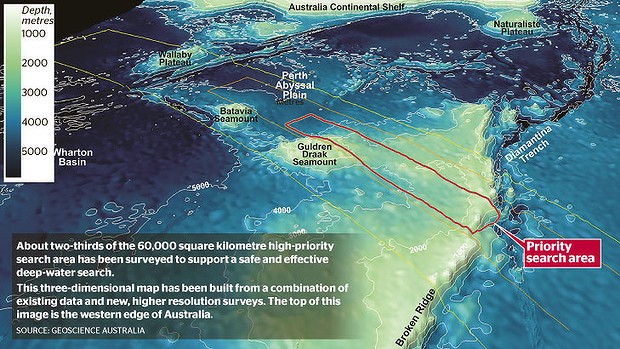
A survey of the 60,000 square kilometer search for the missing Malaysian flight 370 in the Indian Ocean is almost complete, allowing for an accurate map of the sea bed up to six kilometers in depth.
According to the Sydney Morning Herald, two ships that used multi beam sonar have nearly finished their search, allowing for three ships, Equator, Discovery and GO Phoenix, to begin the search for the missing plan by the end of September.
For the next search phase, scanning sonor devices called 'towfish' will be put through the water about 100 metres above the seabed. Towfish will be attached to an armour-plated cable with the length of 10 kilometres to maintain optimum height. The new map will help avoid areas with underwater volcanoes as well as other geological features.
The images from the device will be evaluated by offices in Perth after they are fed through a fibre optic cable. Equipment which helps find evidence of aviation fuel in the water is also present in addition to a video camera and lights to help go closer to the debris identified by the towfish.
Steve Duffield managing director of Fugro, which has one year to search the 60,000 square kilometre priority zone is optimistic about the search.
"The nature of the work is similar to what we do every day," he said.
"What's interesting about this is the size, the depth and the location that is just a long, long way away from anywhere.
"The safety bureau has designated the search area and if it is within our search area we will find it. The law of averages say we could find it as easily on day one as on day 365."
The passenger flight from Kuala Lumpur to Beijing disappeared on 8 March, six months ago next week, with 239 crew and passengers, six of them Australian, all missing.
Safety bureau spokesman Daniel O'Malley said while the search is reliant on complex analysis of limited data and flight information, he is confident that the aircraft will be found.
"This analysis will enable us to prioritise our search within a vast area of the Indian Ocean so we can find the missing aircraft," he said. "We need to remember, though, that it took two years to find Air France flight AF447, whose last position was known with much more precision. We're dealing with a much more challenging set of circumstances.
"The arc associated with the seventh communications handshake is the most reliable information we have. We are confident that the aircraft will be found along that arc. Our task is to determine the priorities for searching on that arc. Priority zones for the underwater search are being finalised and ranked. We can then deploy excellent search technology and skilled crews available to us to search those zones thoroughly. All this work will ensure the best prospects of finding the aircraft and solving the mystery of MH370."














